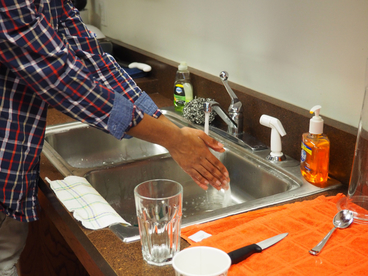Tips for preparing, cooking and storing food at home safely

Wash hands with soap and water.
Wet hands with clean running water and apply soap. Use warm water if it is available. Rub hands together to make a lather and scrub all parts of the hand for 20 seconds. Rinse hands thoroughly and dry using a clean paper towel. If possible, use a paper towel to turn off the faucet.
Sanitize all cooking surfaces.
Surfaces should be washed with hot, soapy water. A solution of 1 tablespoon of unscented, liquid chlorine bleach per gallon of water can be used to sanitize surfaces.
Clean out the refrigerator once a week.
At least once a week, throw out refrigerated foods that should no longer be eaten. Cooked leftovers should be discarded after 4 days and raw poultry and ground meats should be discarded after 1-2 days.
Keep appliances clean.
Clean the inside and outside of appliances. Make sure to also clean buttons and handles!
Clean fresh fruits and vegetables.
After washing your hands, rinse fresh vegetables and fruits under cold running water just before eating, cutting or cooking. Note: Make sure to rinse fruit or vegetables even if you plan to peel or cut them before eating.
Wash, rinse, sanitize and air-dry cutting boards, knives, sinks and other equipment or utensils that will touch fresh produce.
Scrub the surface of firm vegetables using a clean and sanitized brush designated for this purpose. Rub softer vegetables with your hands under running water. For leafy greens such as kale, rinse the leaves under running water and then pat dry with a paper towel or use a salad spinner.
Label, date and refrigerate fresh-cut items.
Separate foods when shopping.
Place any raw seafood or meat in separate bags.
Separate foods when preparing and serving.
Always use a clean cutting board for fresh produce and separate one for raw seafood or meat. Never place cooked food back on the same plate or cutting board that previously held raw food.
Use a food thermometer.
A food thermometer can help you make sure that food is safely cooked to the right temperature and that it stored at the right temperature in your fridge or freezer.
Cook food to safe internal temperatures.
Checking the internal temperature of seafood, meat and egg dishes is a great way to keep your food safe. Cook all raw beef, pork, lamb, steaks, chops, and roasts to an internal temperature of 145 degrees. Cook all raw ground beef, pork, lamb and veal to an internal temperature to 160 degrees. Cook all poultry including ground turkey and chicken to an internal temperature of 165 degrees.
Keep foods at safe temperatures.
Store cold foods at 40 degrees or below. It works well to refrigerate leftovers in shallow containers so hot food can cool more quickly.
Temperature chart
| Food | Minimum internal temperature | |||
|---|---|---|---|---|
| Beef, pork, veal and lamb | 145° F | |||
| Ground meats (venison, goat, lamb) | 150° F | |||
| Ground poultry | 165° F | |||
| Ham (fresh or smoked), uncooked | 145° F | |||
| Fully cooked ham (to reheat) | Reheat cooked hams packaged in USDA-inspected plants to 140° F and all others to 165° F | |||
| All poultry (breasts, whole bird, legs, thighs, wings, ground poultry, giblets and stuffing) | 165° F | |||
| Eggs | 160° F | |||
| Fish and shellfish | 145° F | |||
| Leftovers | 165° F | |||
| Casseroles | 165° F |